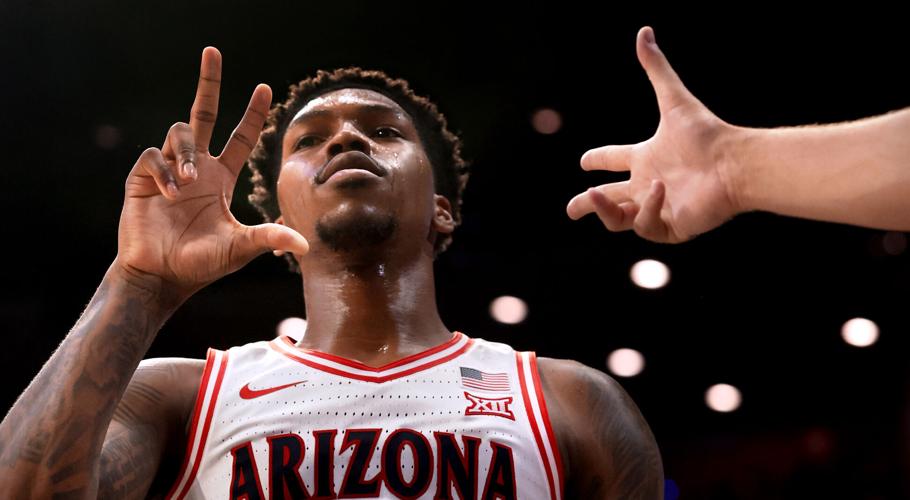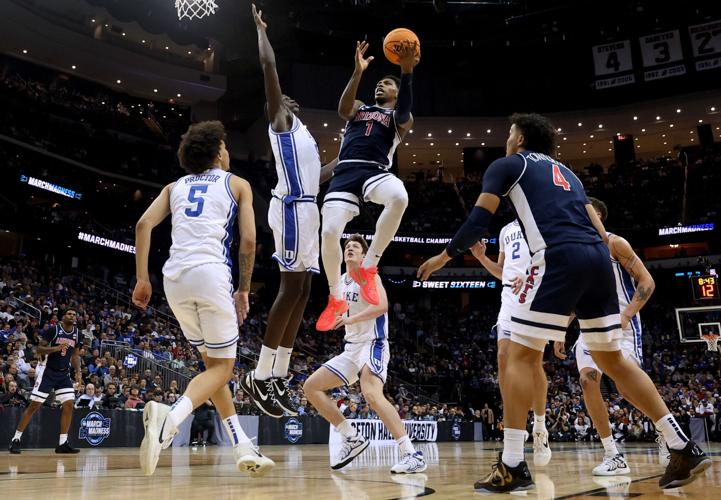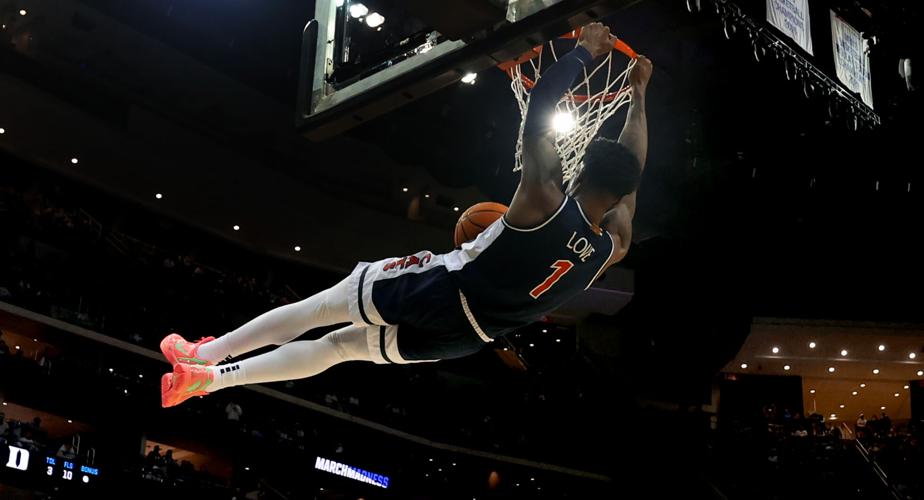УлшжжБВЅтs Caleb Love is trending upward into the 2025 NBA Draft, but itтs not really about the 2,762 points he scored in college, including that 60-foot buzzer bomb he hit against Iowa State last season.
Nor is it all about the 28 points he dropped on Duke in the 2022 Final Four, nor the 35 he had on the Blue Devils in the 2025 Sweet 16. Probably not even his 2024 Pac-12 Player of the Year award, either.
Instead, like so many trends in high-level basketball these days, you can probably trace a lot of it to NIL.
A year after NIL appeared to prompt Love to withdraw from the draft because he would likely earn more at УлшжжБВЅ last season than as a borderline NBA prospect, the trend accelerated this spring: Players uncertain of a first-round NBA pick who still had eligibility left often stayed in college to sign seven-figure NIL deals, assuring them of well more than a standard two-way contract that pays less than $600,000.
People are also reading…
As a result, that left more room for prospects who didnтt have college eligibility to move up т to get a second-round pick, a two-way contract, or just a better opportunity.

УлшжжБВЅ guard Caleb Love (1) sails through the lane looking for room to put up a floater against Duke during the second half of their Sweet 16 game in the menтs NCAA Tournament in Newark, NJ, on March 27.
Rated No. 89 before last season on NBA prospects т and left off it entirely in editions released during last season т Love now stands at No. 69.
тI think all the guys pulling out of the draft helped him quite a bit,т ESPN draft analyst Jonathan Givony said on a media Zoom conference Monday. тItтs definitely not out of the question that he hears his name called in the 50s and, if not, he could very well earn himself a two-way contract, summer league (contract) or whatever.т
has Love rated No. 61 among the top 100 draft-eligible prospects, implying heтd theoretically be the second player not taken in the 59-player draft, while ranks Love at 63.
That sort of position arguably sets a player up better than a mid- to -low second round selection, since the player gets to pick the team with the best opportunity competitively and financially.
тItтs about finding the right home and the right fit,т Bobby Marks, ESPNтs тFront Office Insiderт said when asked about Love on a conference call Monday. тSometimes getting drafted looks good on your Wikipedia page, but itтs тWhere can you go?т т
Marks said Love is тat worst a two-way guy,т meaning he could at least warrant that six-figure contract that allows him to split time between the NBA and G League. Marks compared Loveтs situation to that of Philadelphia forward Justin Edwards, who went undrafted out of Kentucky last year but played his way from a two-way deal into a standard deal.
Edwards wound up playing 44 games and averaging 26.3 minutes for the Sixers in part because of the teamтs injuries. But while Edwards is a different player than Love, with different skills and size, Marks indicated heтs an example of what a properly selected two-way deal can lead to.
They can lead to opportunity, in Loveтs case the chance to prove heтs more than just a 6-4 volume scorer with sometimes less than ideal efficiency. He averaged 17.6 points over two seasons at УлшжжБВЅ despite shooting only 33.6% overall, but improved defensively and on the ball.

УлшжжБВЅ guard Caleb Love hangs from the rim after getting a break away dunk in the second half against Duke in a Sweet 16 NCAA Tournament game in Newark, N.J., March 27.
Love may have to do more of all that to stick in the NBA.
тThe defensive side is probably going to be really important for him,т Givony said. тI think heтs been a little bit inconsistent on that end of the floor. The shot selection has always been a question mark, and the playmaking ability, finding guys.
тHe has a career 43.2% two-point percentage, so heтs obviously not a high-level finisher, with a lot of tough mid-range jumpers. So those are probably going to be the key elements that teams are going to be looking for to see if he could carve out a role as a combo guard off the bench long-term.т
To see if he can, basically, beat some pretty long odds.
тItтs hard to be a combo guard in the NBA,т The Athleticтs Sam Vecenie wrote in his analysis of Love. тYou have to essentially be elite as a shooter and as a scorer. You have to be ridiculously gifted and consistent to make this kind of game work.т
After a workout with the Portland Trail Blazers last month, Love said NBA executives have told him they like his physicality and defensive potential, but that he knew he would have to improve his shot selection while playing with better talent in the NBA.

УлшжжБВЅ guard Caleb Love (1) celebrates his 20th point of the night, a three in front of the Wildcat bench, in the second half against Utah on Feb. 26.
тMy decision-making on the catch, making quick decisions, I think thatтs gonna help me,т Love said.
Especially with the unique leverage he likely will find in this yearтs draft pool, Love will at least get an opportunity to show he can make it work.
УлшжжБВЅ coach Tommy Lloyd said he was т100% sureт Love would be in the NBA next season, though he later indicated Love would still have work to do.
тI think the right person is тІ going to make a well-informed basketball decision, and theyтre going to be like, тCaleb Love is really talented. I donтt know how many guys can go out and score 35 points, easy, on Duke,тт Lloyd said. тI mean, he showed you something there. He might be a little inconsistent but I know thereтs not too many guys that can do that.
тAnd sometimes when youтre evaluating and building a team, when a guy shows you his ceiling, you pay attention: тWow. He can score 35 on Duke in an NCAA tournament game? Letтs dig deeper on this one,т and then figure out, тHow can I get this guy to hit his ceiling more often? And how can I raise his floor?т Thatтs what those guys do.
тSo Iтm very confident that Calebтs going to earn an opportunity to be on an NBA roster. Then from there, heтs got to make the best of it.т



















